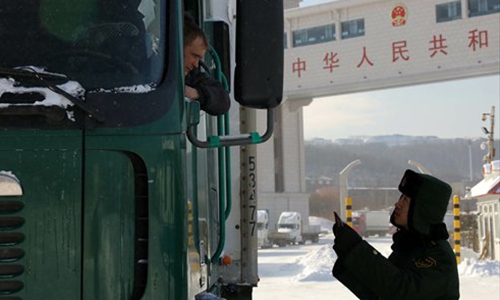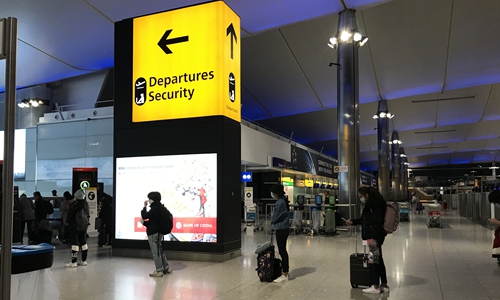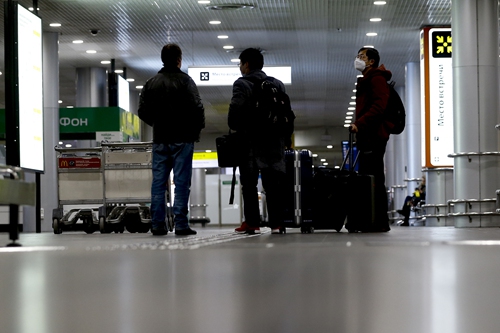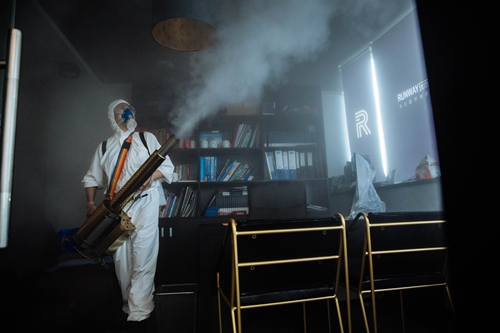China’s new coronavirus battlegrounds
Editor's Note:
After Wuhan, capital city of Central China's Hubei Province hit hardest by the COVID-19 pandemic in the country, lifted its city lockdown after 76 days in isolation to contain the novel coronavirus spread, China officially entered the next stage of combating the virus.
How can growing risks from imported infections and a possible rebound in domestic cases be prevented? How can production and social activity be gradually restored while the risk of a second outbreak is controlled? How can the world's factory regain its momentum amid shrinking external demand due to the virus spread, considered as the largest 'black swan' event of the year and worst crisis since World War II? This is the first part of a three-part series featuring the new challenges China faces in the aftermath of the COVID-19 pandemic.

A security officer checks a truck at the border checkpoint in Suifenhe in Northeast China's Heilongjiang Province.Photo: IC
Since China reported its first imported novel coronavirus pneumonia (COVID-19) case from Iran in Northwest China's Ningxia Hui Autonomous Region on February 26, the country's battle against the virus has been expanding from the domestic domain to a larger scope. As the global battle rages on, authorities have stepped up prevention and control work in fending off risks of imported infections, particularly after China recorded no new domestic cases for the first time on March 19 while steadily and cautiously resuming business in preventing a resurgence of locally transmitted infections.
Such an unprecedented public health crisis brings challenges to not only the Chinese government and people but also to the world as it has been dramatically changing the way people work, live and think. The worsening pandemic has become a major test for governments around the world. Following a series of failures in handling the crisis in some Western countries including the world's leading power, the US, escalating ideological confrontations have also become more palpable, reshaping the public mindset in the world's second-largest economy in confronting growing external uncertainties.
New battlegrounds
Suifenhe, a border town of China and Russia in northeastern Heilongjiang Province, has been on high alert in recent days as the city, with about 70,000 residents with limited medical resources, has seen a rapid increase in imported COVID-19 infections.
Following fewer flights between Russia and China amid the outbreak, imported cases through the Suifenhe land port increased. Official data showed that from March 21 to Tuesday, 2,443 people crossed through the Suifenhe land port, with confirmed imported cases reaching 84 and asymptotic patients 127, media reported.
The Heilongjiang health authority said on Thursday that the province recorded no new domestic infections on Wednesday but 40 new imported cases from Russia, of which 39 were through the Moscow-Vladivostok-Suifenhe route.
Some photos and videos circulating on social media showed that customs employees, health inspection workers and border police at Suifenhe have been fully equipped, wearing white protective suits, and waiting for arrivals from Russia, and some netizens said "when the Wuhan battle comes to an end, thousands of miles away, another defense battle starts."
Starting Wednesday, all residential compounds in Suifenhe began conducting seal-off management, which allows one person per household to go shopping every three days, which some local residents consider the strictest prevention and control measures since the outbreak, online videos showed.
Prevention and control work against imported infections has also been shifting its focus from screening arrivals from hardest-hit countries at the early stages of the outbreak including Iran, the UK and Italy to arrivals from those recording rapid increases in domestic infections, especially countries that have not flattened the curve of the pandemic, some medical experts said.
For instance, from March 18 to 22, imported infection from countries such as the UK, Spain, France and the US grew rapidly, and the UK was the country where most imported cases came from. Most imported cases were mainly from Iran in earlier March, then in mid-March, the cases were mainly from Europe, the US, and some Southeast Asian nations, media reported.

Passengers queue up for security checks before departing for Beijing, China, at London Heathrow Airport on March 28. Photo: Sun Wei/GT
"Our measures to prevent imported cases have been escalating, such as requiring a 14-day quarantine, barring the entry of most foreign arrivals, specially targeting places with potentially rapid infection growth, while making long-term preparations," Wang Peiyu, deputy head of Peking University's school of public health, told the Global Times on Thursday.
A Financial Times graphic shows Italy on the verge of an inflection point as the rate of deaths has begun to decline, but countries like the UK, France and the US are still in the acceleration phase.
Russia also reported 1,459 new cases on Wednesday -- a record high for a single day, leading to the total confirmed cases of 10,131.
Some countries have yet to achieve an inflection point and daily confirmed cases continue to rise, while the virus spread could be seasonal. The situation in countries and regions like India and Africa, which lack adequate prevention with limited medical resources, may become more severe in the coming months.
Zeng Guang, chief epidemiologist at the Chinese Center for Disease Control and Prevention, told the Global Times on Thursday that it's difficult to predict the inflection point of imported cases due to several unknown factors.
Zeng said that, so far, only a small number of the 1.6 million overseas Chinese students have returned, and the infection severity of overseas Chinese who have returned is not necessarily consistent with the global epidemic situation.
For example, the COVID-19 epidemic in Russia is not so severe, but the number of Chinese who returned and tested positive is quite large, he noted.
More Chinese students in Russia are now worried about the worsening pandemic in the country, and have been struggling about whether to return to China or stay in Russia, both likely exposed to growing risks.
Han Muyao, who studies at the National Research Nuclear University MEPhI (Moscow Engineering Physics Institute), told the Global Times that he really wants to return to China, but he chooses to stay because the school has not announced exam schedules.
Han has been taking online courses since mid-March. He has stayed indoors since then.

Passengers are seen after COVID-19 examinations at Sheremetyevo International Airport in Moscow, Russia on February 26. Photo: AFP
Due to the rapid increase of confirmed cases in some neighboring countries, China recorded increases in imported cases, and authorities at all levels have been urged to take strict border inspection and enforce quarantine measures to minimize domestic transmission triggered by imported cases, the National Health Commission said on Thursday.
The Chinese mainland reported 61 new imported cases on Wednesday, bringing the total to 1,103. And asymptomatic cases from foreign countries reached 28.
Xi Jinping, general secretary of the Communist Party of China (CPC) Central Committee, called for preparedness in mind and work to cope with prolonged external environment changes at a meeting on Wednesday, urging unremitting efforts to guard against imported cases and prevent a resurgence of the outbreak at home, the Xinhua News Agency reported.
He also demanded redoubling efforts in economic and social development.
While border customs have become the new battlefield in combating the coronavirus, authorities have been allocating resources and mobilizing frontline workers in border testing and screening. For example, the General Administration of Customs has built or converted five P2 laboratories and added 40 new nucleic acid extraction instruments, increasing the customs testing capacity from 7,000 to 17,000 persons, according to an official statement released on Thursday.
With the strengthening of international flight controls as imported cases grow, land ports have recently become the focus of virus prevention.
Given China 's land ports, especially those in the northeastern and southwestern regions, are mostly in remote and less developed areas, lack of governing capacity and inadequate medical resources increase risks and challenges, observers said.
Several medical experts who spoke to the Global Times said the public is highly likely to co-exist with the coronavirus for a relatively long time, and while the vaccine is highly anticipated, it won't come within the coming months.
As regular prevention and control work continues in several battlegrounds such as community-based prevention work and border customs inspection, it is also time to embrace the new normal.
Changing mindset
As the pandemic continues to worsen globally, the blame game has erupted, including ideological confrontations amplified by different narratives, especially between China and the West. Hostility toward foreigners in China has reportedly increased amid fears of imported infections while more Chinese people living overseas have experienced discrimination amid the anti-Chinese sentiment.
The crisis caused by the COVID-19 pandemic is likely to have just begun, and there will be more and more serious challenges from the pandemic in geopolitics, some Chinese political observers said.

Thursday is the second day since Wuhan lifted its 76-day lockdown. Office buildings and markets are preparing to reopen while public transport has become busier. Everything in Wuhan is reviving. Photo: Li Hao/GT
Some predicted that the outbreak would lead to more severe turbulence and severely impact the global order, giving rise to extreme nationalism and populism, and China could become the target of Western countries like the US to divert their domestic disappointment and anger over their failure in handling the outbreak. Preventing imported infections and insisting on the country's continuous opening-up to the world are major tasks for the second half of the war against COVID-19, observers said.
"We need to focus on the aftermath of the outbreak during the second half of the battle, including advancing social and economic development as well as focusing on the public mindset," Yang Zhanqiu, a virologist at Wuhan University, told the Global Times on Thursday.
From the early stages of the outbreak marked by anxiety and outrage toward a delayed response, to containing the domestic transmission within two months, "there has been a new consensus among Chinese officials and the public that the confidence in our institutional advantages has been significantly strengthened," he said.
Zhang Wenhong, head of Shanghai's COVID-19 clinical expert team, told a public forum on Wednesday that the global pandemic is likely to last one or two years. For the foreseeable future, the global healthcare system would be on alert and the public will live and work normally, Zhang said.
As long as the epidemic exists, there will always be risks, Zhang noted.